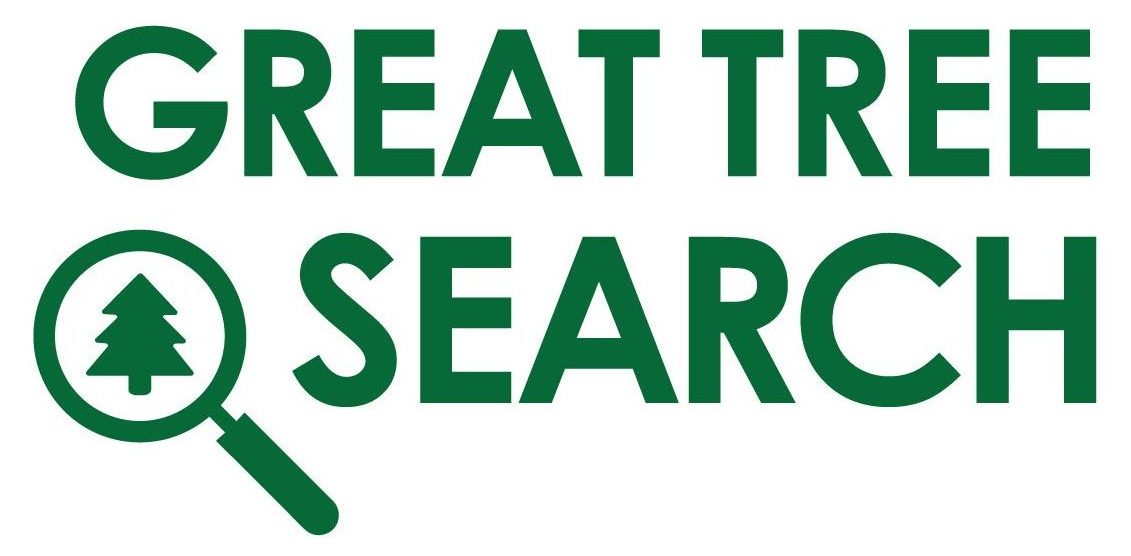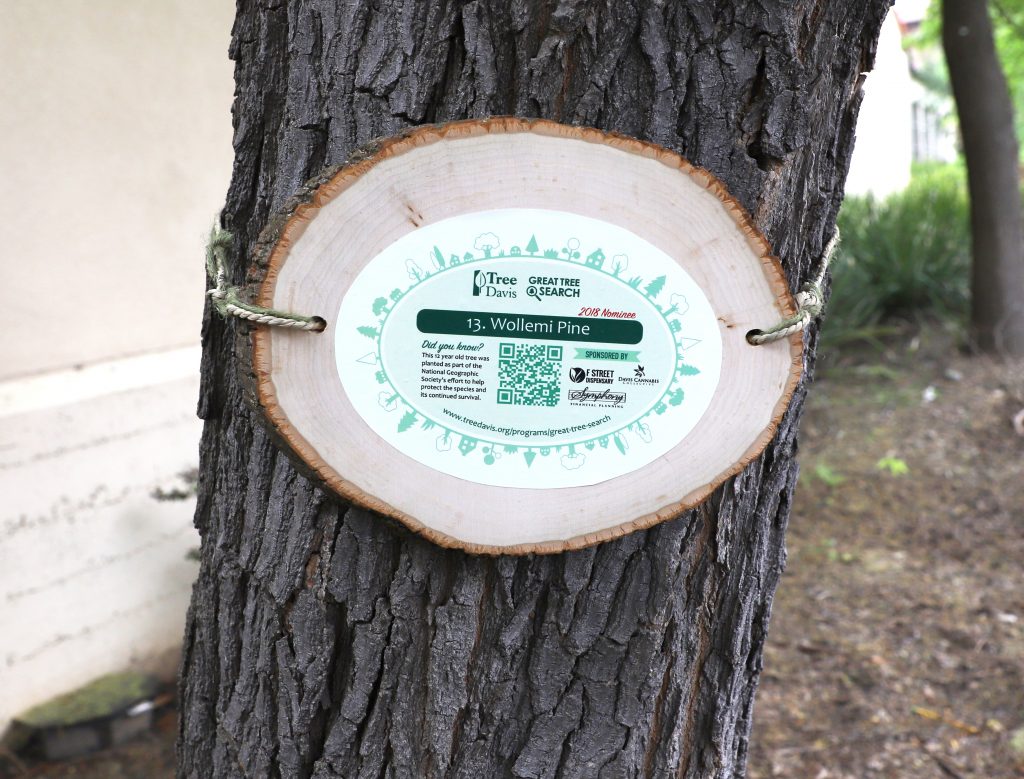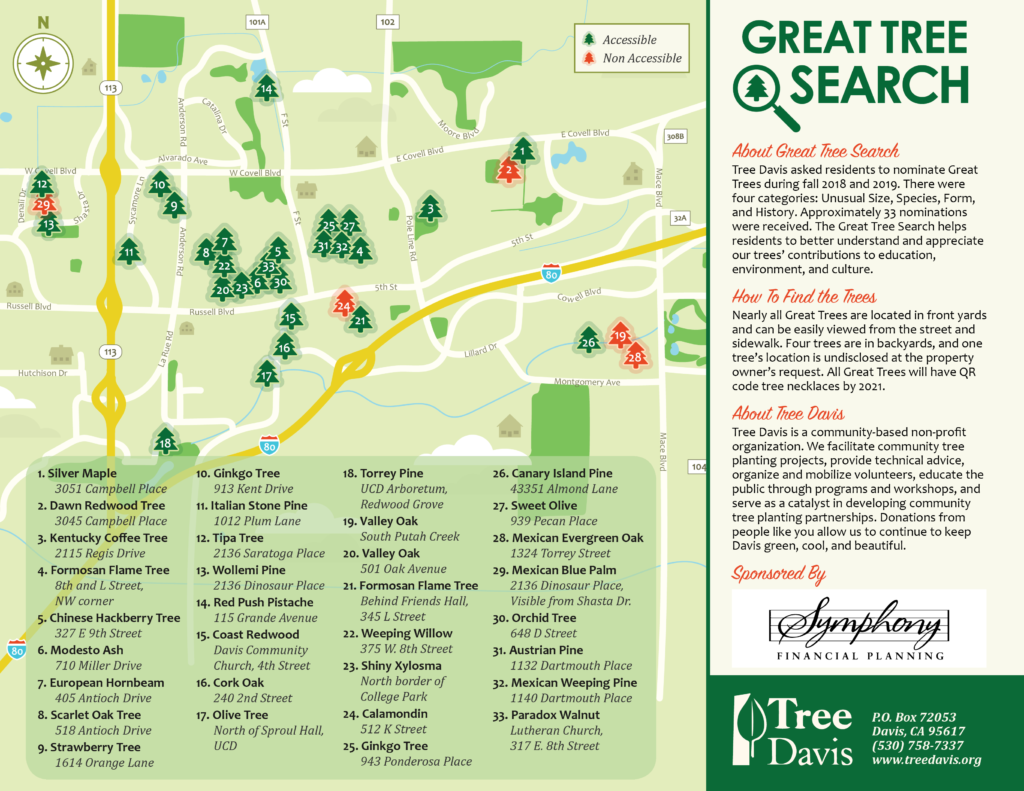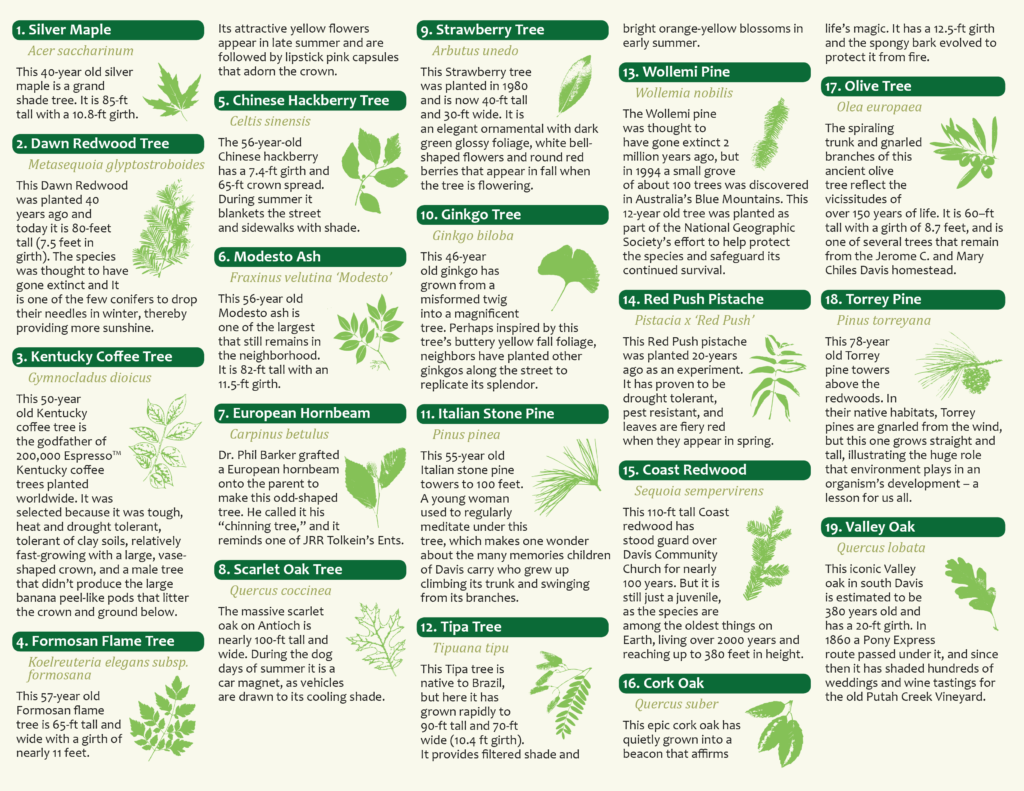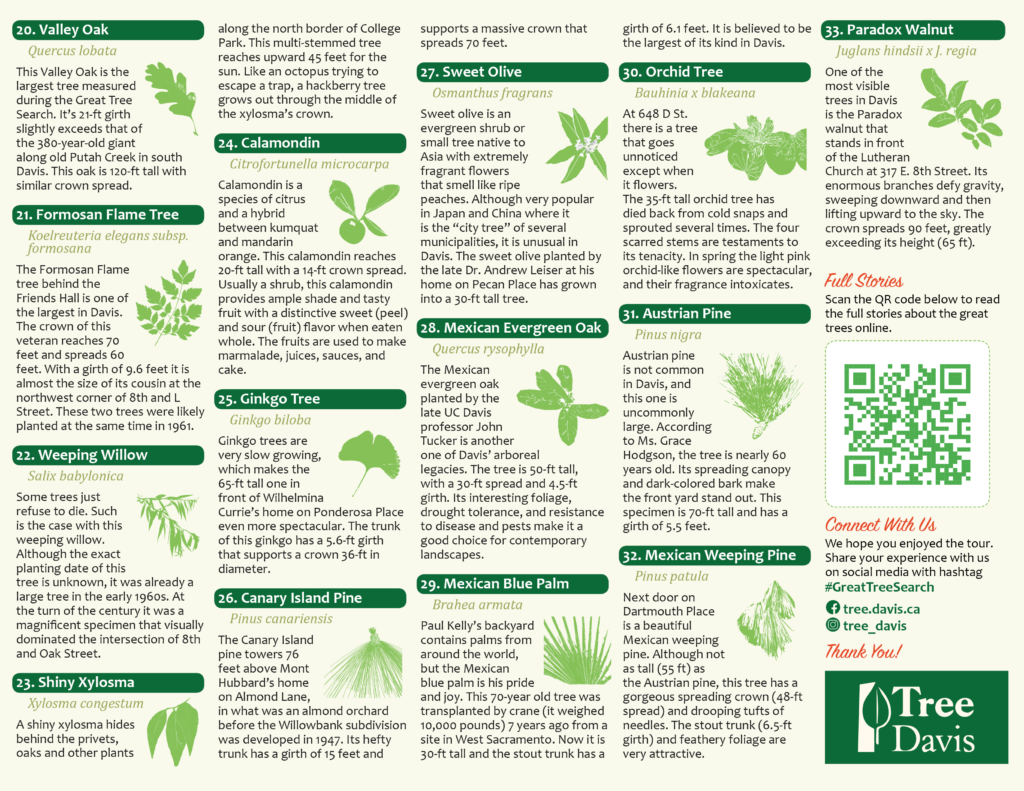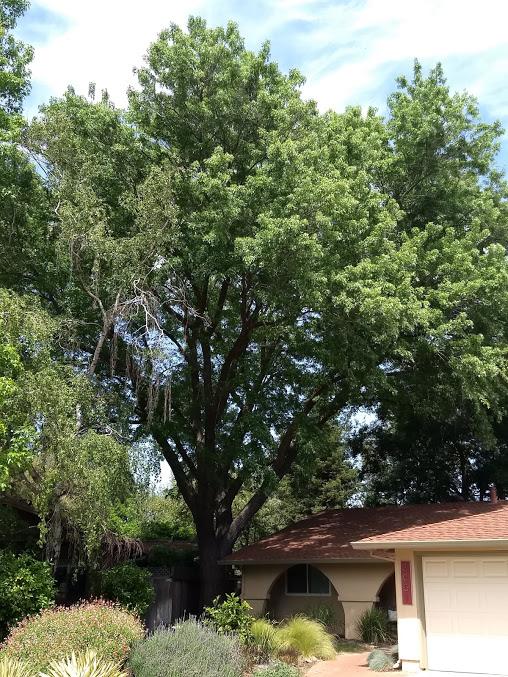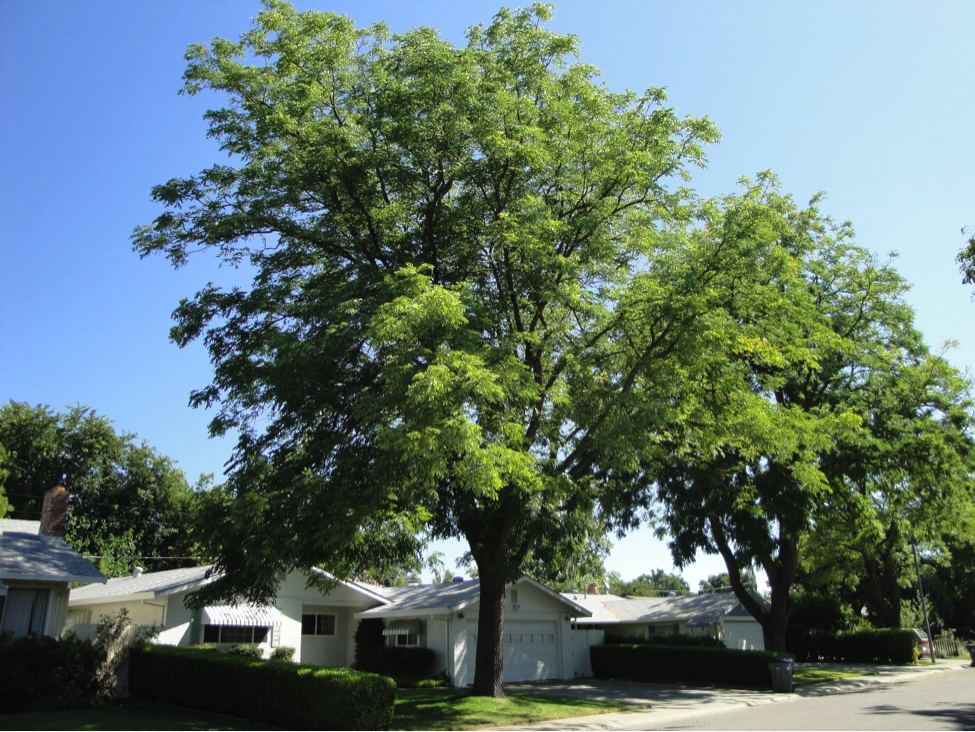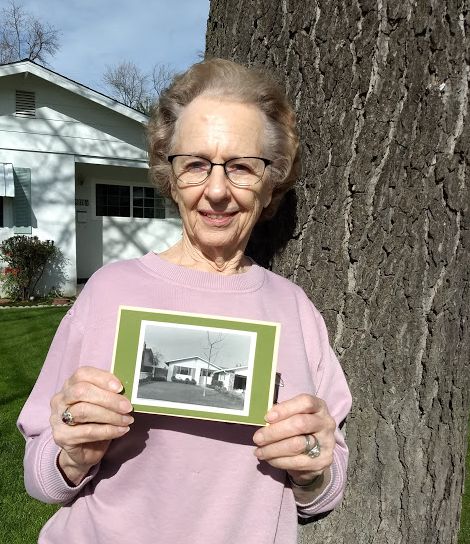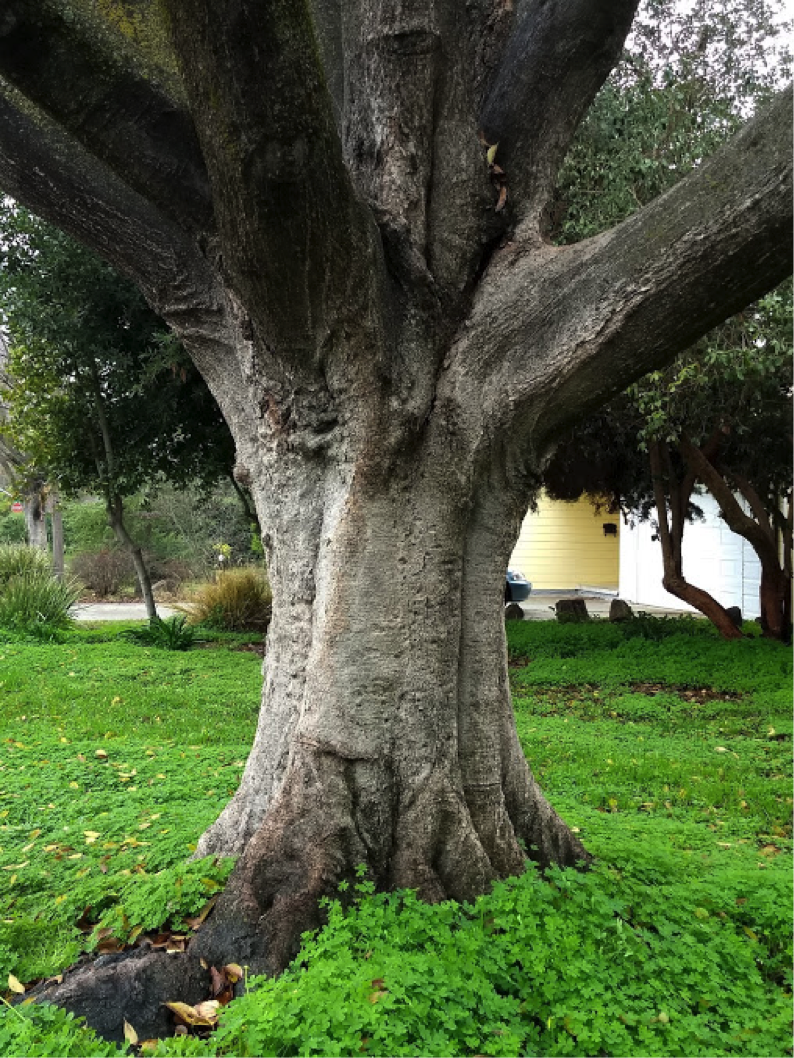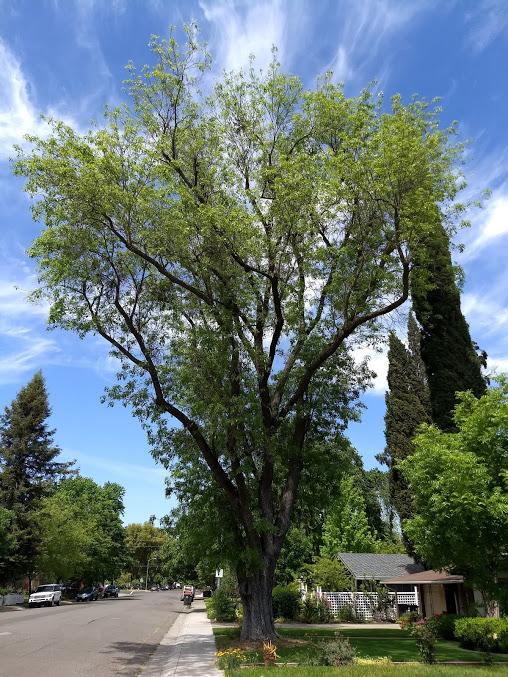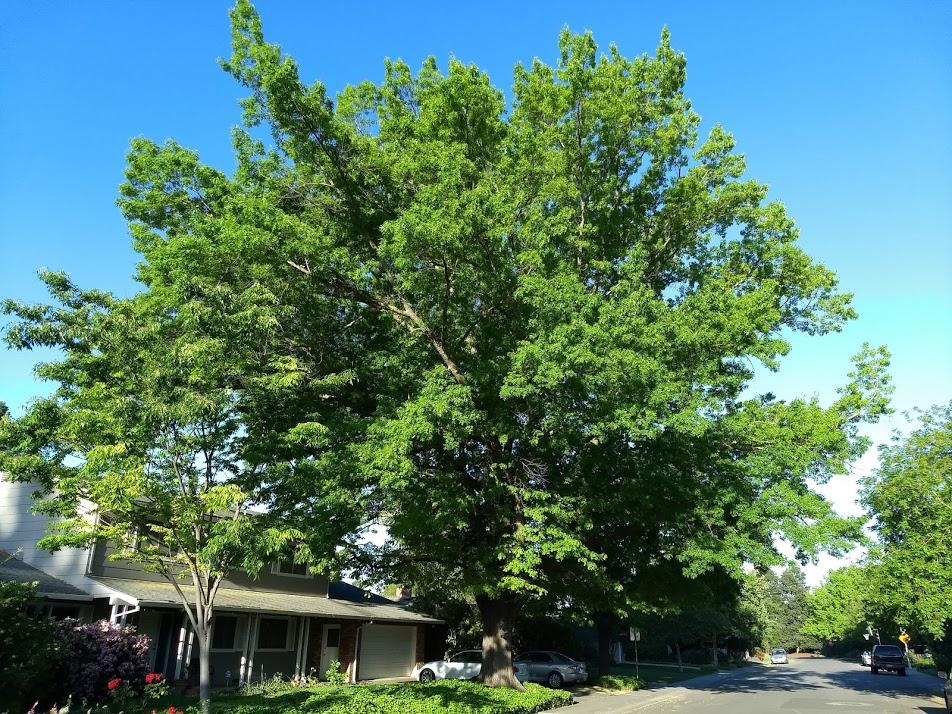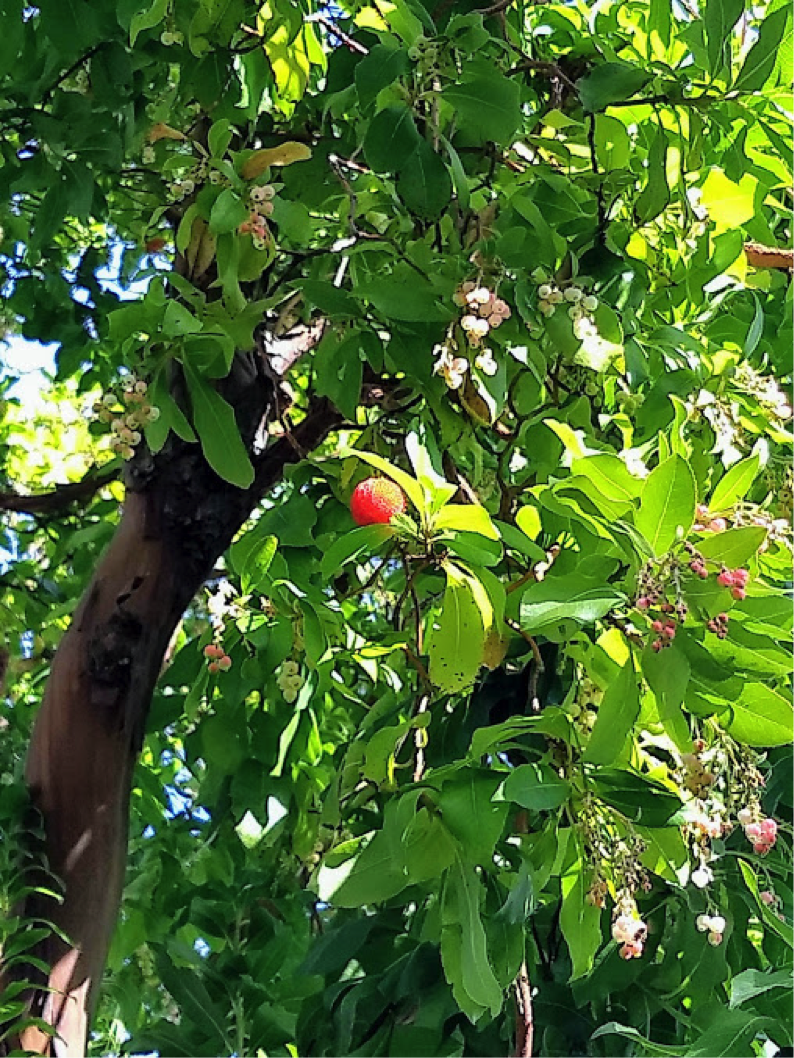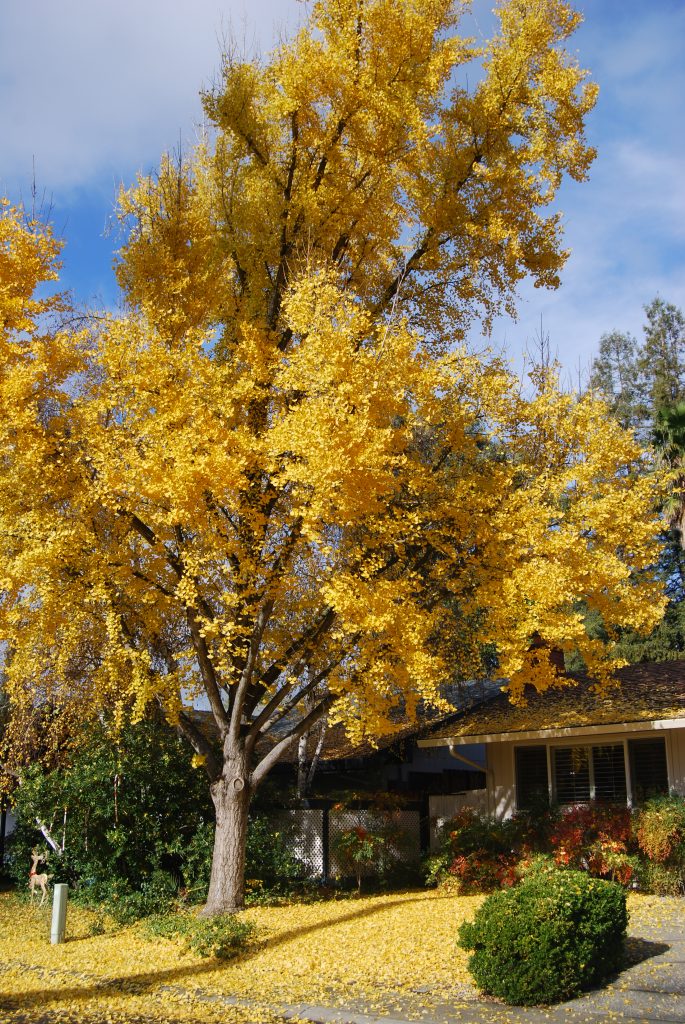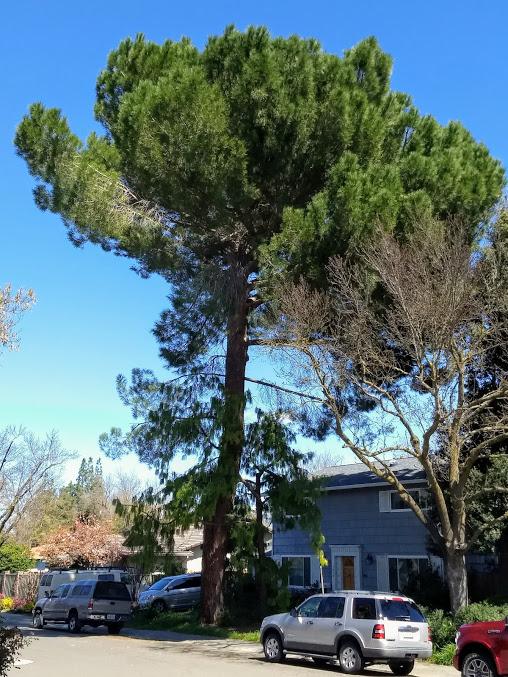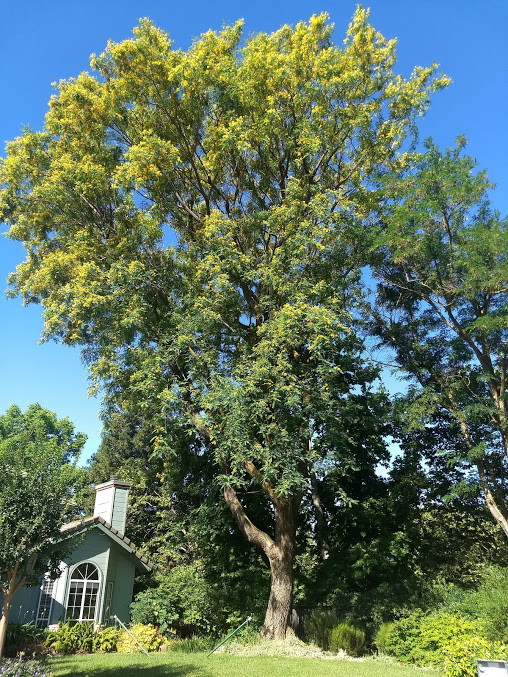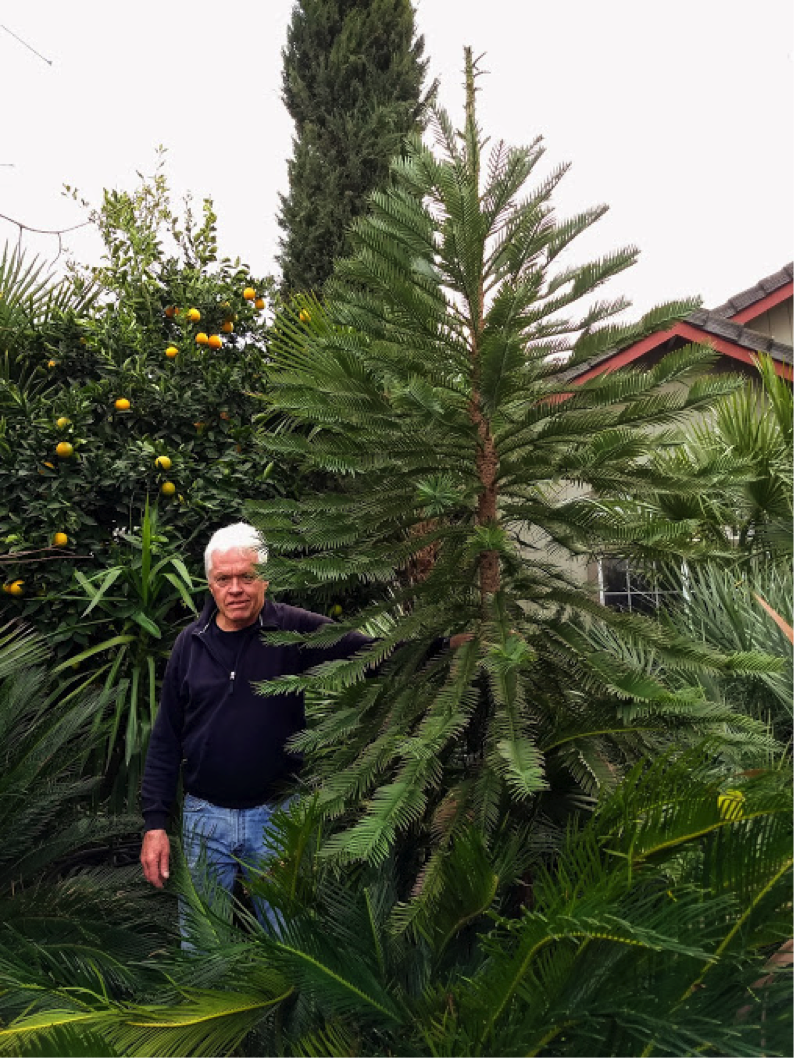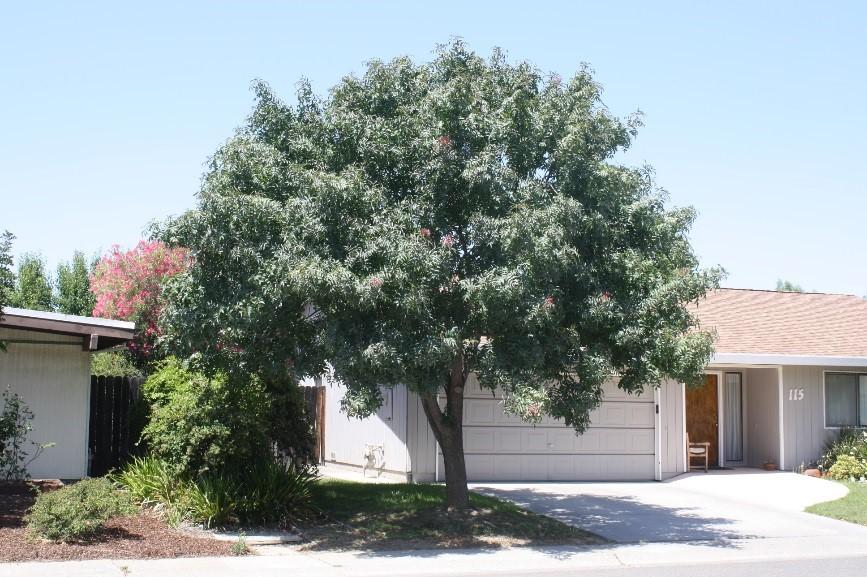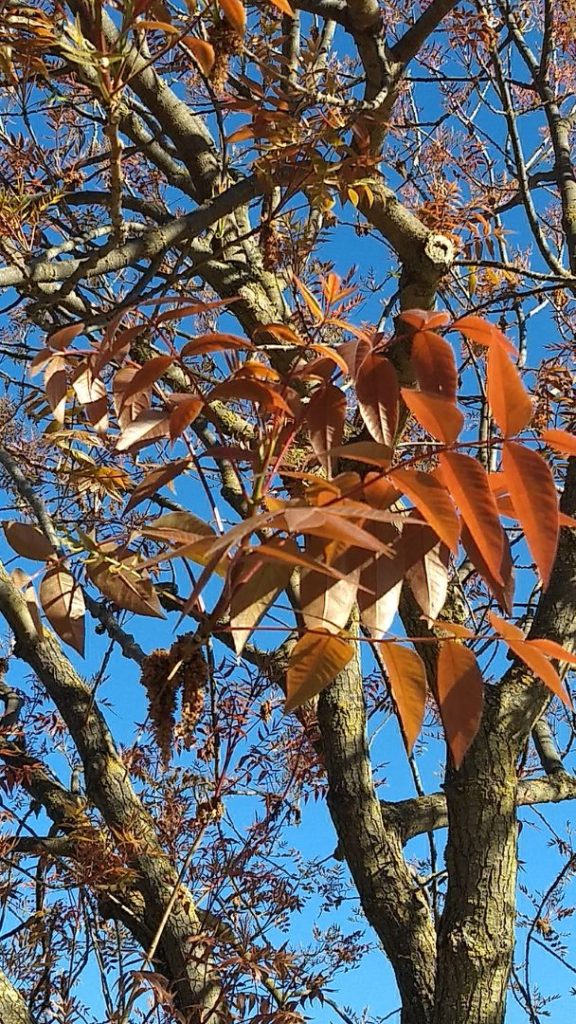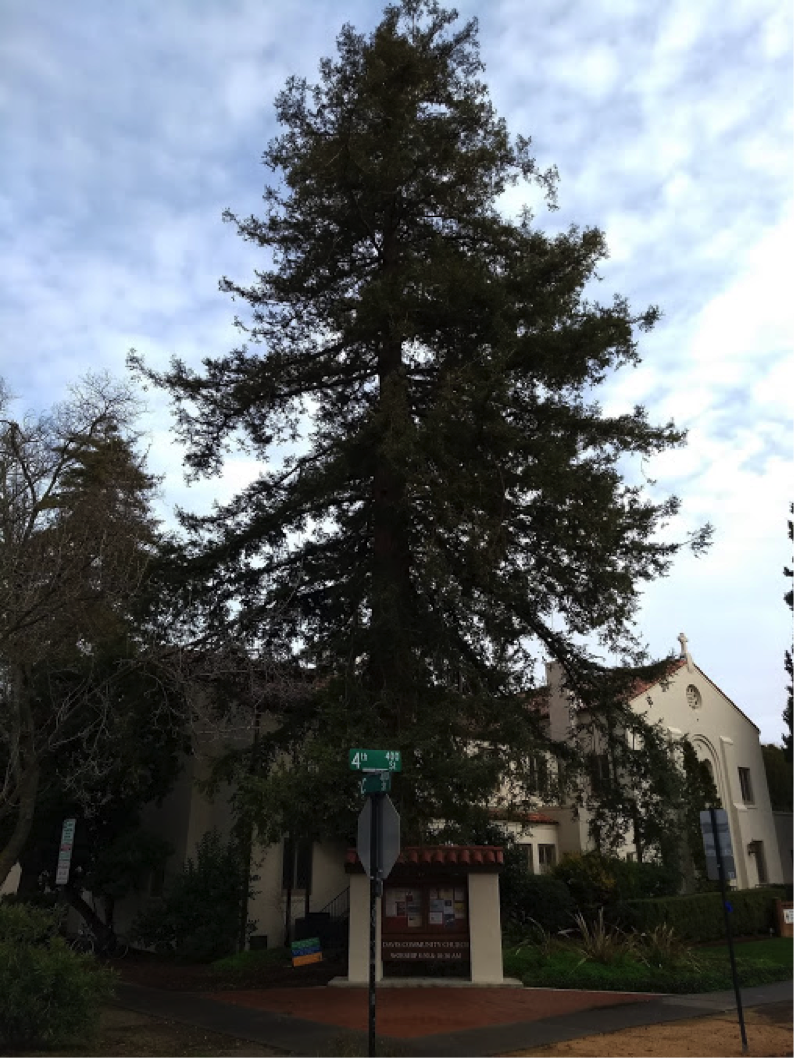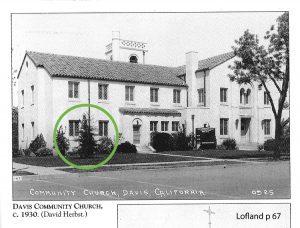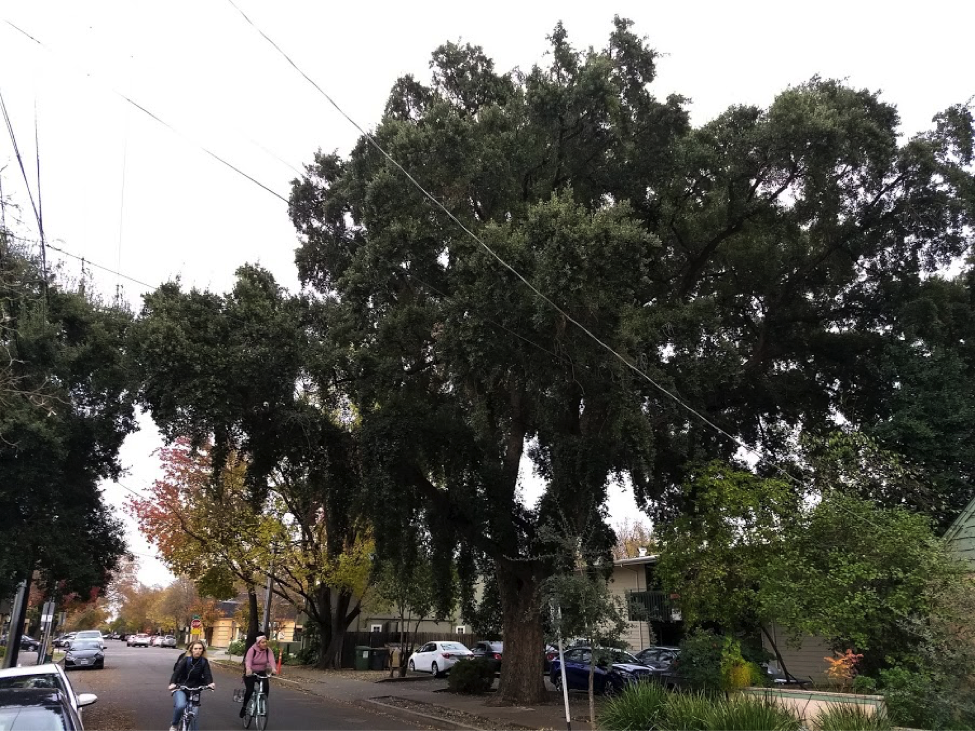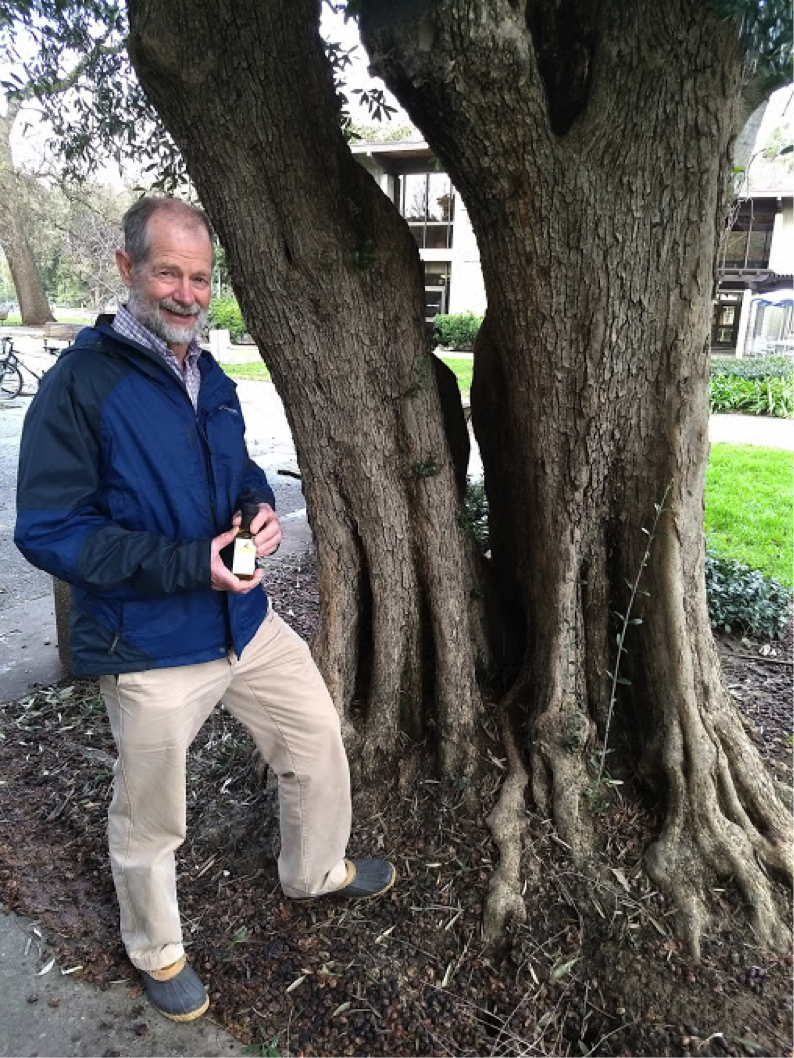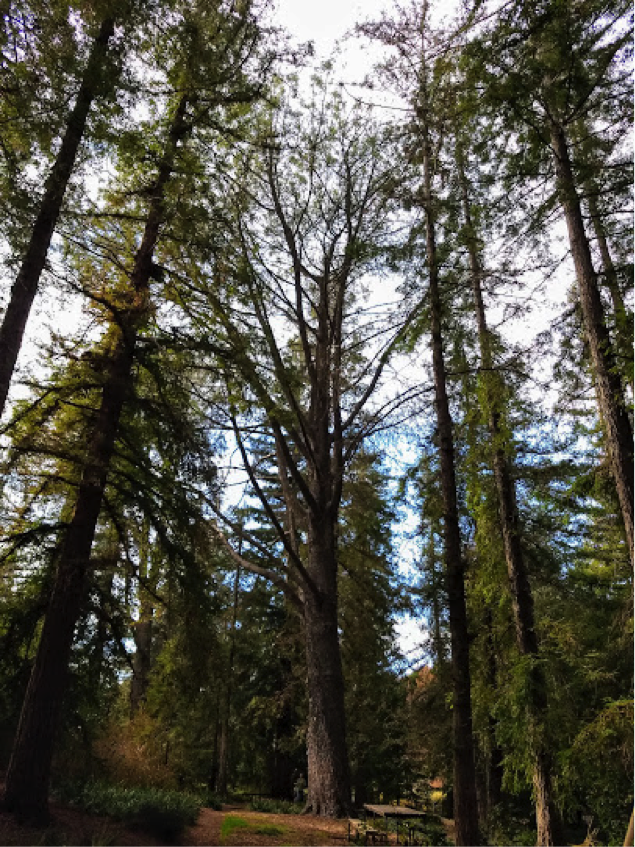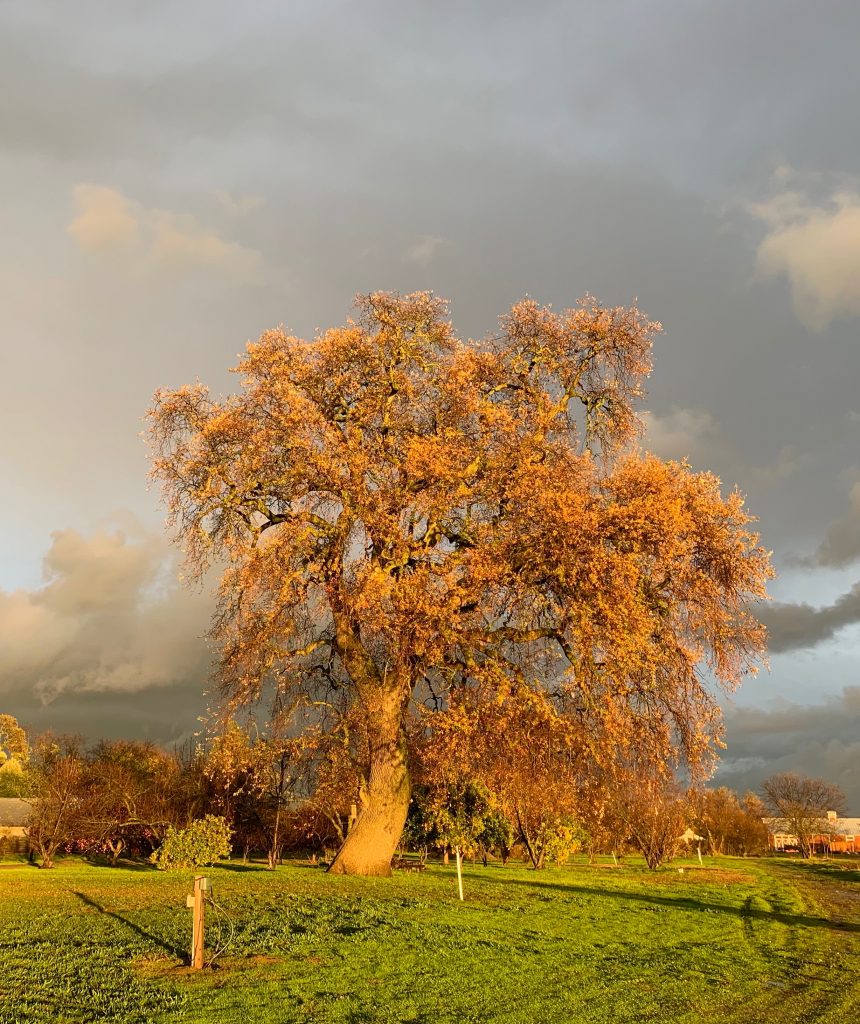About Great Tree Search:
Tree Davis asked residents to nominate Great Trees during fall 2018 and 2019. There were four categories: Unusual Size, Species, Form, and History. Approximately 33 nominations were received. The Great Tree Search is helping residents better understand and appreciate the educational, environmental, and cultural contributions of our trees.
How to Find Trees:
Nearly all Great Trees are located in front yards with QR code tree necklaces and can be easily viewed from the street and sidewalk. Several trees are in backyards and one tree’s location is undisclosed at the property owners request.
How to Nominate Future Great Trees:
There are many unusual trees in Davis’s yards and parks that add botanical diversity, beauty and history to our community. We are calling on the residents of Davis to nominate Great Trees that grace the private and public landscapes. Share your Great Tree nominations(s) with us by clicking the link below, and Tree Davis volunteers will follow-up to arrange a time to measure and photograph your nomination(s).
Great Tree Search Nomination Form
Great Tree Search Nomination Form (downloadable version)
We Thank The Sponsors Who Helped Make The Great Tree Search Possible:
Great Tree Search Map
WANT TO PRINT THIS MAP? DOWNLOAD PDF VERSION HERE!
Learn More About Our Great Trees
1. Silver Maple
(Acer saccharinum)
Location: 3051 Campbell Place
Nominator: Jean Meyer
This 40-year old silver maple is a grand shade tree.
This tree provides an enormous amount of shade. However, silver maples are not very well suited to the hotter, drier and windier conditions we can expect in the future. They require ample irrigation and plenty of space to grow.
Category: Unusual Size
Age: 40
Height: 85 ft
Spread: 70 ft
Girth: 10.8 ft
2. Dawn Redwood
(Metasequoia glyptostroboides)
Location: 3045 Campbell Place
Nominator: Jean Meyer
About 40 years ago Ms. Jean Meyer and her family selected and planted a Dawn Redwood tree in their backyard on Campbell Place in East Davis. They had heard that it was called a living fossil, and found one at Capitol Nursery in Sacramento.
This Dawn Redwood was planted 40 years ago and today it is 80-feet tall (7.5 feet in girth). The species was thought to have gone extinct and It is one of the few conifers to drop their needles in winter, thereby providing more sunshine.”}” This Dawn Redwood was planted 40 years ago. The species was thought to have gone extinct and It is one of the few conifers to drop their needles in winter, thereby providing more sunshine.
In 1944, a small stand was found in China, and by 1950 seedlings were being distributed to U.S. arboretum and universities. Today it is 80-feet tall (7.5 feet in girth) and provides welcome summer shade over her backyard patio. Dawn Redwood is one of the few conifers to drop their needles in winter, thereby providing more sunshine. This trait is considered a symbol of constant renewal. Ms. Meyer enjoys her tree’s lush fern-like foliage in summer and attractive foxy red-brown color in fall. The small woody cones hearken to the species’ coniferous quality. Ms. Meyer is confident that her Dawn Redwood will continue to keep giving her a great deal of joy.
Category: Unusual Size
Age: 40
Height: 80 ft
Spread: 60 ft
Girth: 7.5 ft
3. Kentucky Coffee Tree
(Gymnocladus dioicus)
Location: 2115 Regis Drive
Nominator: Martha Brashear
This 50-year old Kentucky coffee tree is the godfather of 200,000 Espresso™ Kentucky coffee trees planted worldwide. It was selected because it was was tough, heat and drought tolerant, tolerant of clay soils, relatively fast-growing with a large, vase-shaped crown, and a male tree that didn’t produce the large banana peel-like pods that litter the crown and ground below.
Category: Unusual Size and History
Age: 50
Height: 54 ft
Spread: 63 ft
Girth: 7 ft
In the 1950s and 60s, members of the Davis Tree Commission, including Dr. Richard Harris and Dr. Phil Barker, worked with the city to plant and evaluate the performance of different species of trees along new streets in east Davis. Their goal was to diversify the mix of species with trees proven to be well-adapted to local conditions.About 20 Kentucky coffee trees were planted along Regis Drive in the late 1960’s.
During his annual observations US Forest Service research horticulturist Dr. Barker saw that the tree in front of the Brashear’s home (2115 Regis) stood out as exceptional. In 1986 Dr. Barker invited Horticulturist Keith Warren of J. Frank Schmidt Nursery in Oregon to see the tree. Martha Brashear, who nominated the tree, remembers her husband and others measuring and studying the tree that by now shaded and cooled their home. It was pronounced a favorite because it had all of the desirable features of the species without the troublesome traits. It was tough, heat and drought tolerant, tolerant of clay soils, and relatively fast-growing with a large, vase-shaped crown. It was a male tree, so seeds were not produced, and the large banana peel-like pods didn’t litter the crown and ground below.Barker sent cuttings to Warren for propagation and evaluation. Over the next decade, the nursery struggled to find an effective way to propagate clones genetically identical to this parent tree.
Eventually they refined their techniques, named and trademarked it as ‘Espresso-JFS’, and offered the new tree in their 1994 catalog. Despite ongoing production challenges, by 2010 they were steadily producing trees for sale and began to highlight the handsome tree on Regis Drive in their marketing materials.
Today, Espresso™ Kentucky coffee tree is the most popular and widely planted coffee tree cultivar in the country. The iconic tree on Regis Dr. stands 55-ft tall with a girth of 7 ft. It is truly one of Davis’s Great Trees. Planted 50 years ago as an experiment, it is the progenitor of thousands of Espresso™ Kentucky coffee trees planted annually worldwide.
4. Formosan Flame
(Koelreuteria elegans subsp. formosana)
Location: 8th and L Street. NW corner
Nominator: Neil J. Rubenking
The attractive yellow flowers appear in late summer and are followed by lipstick pink capsules that adorn the crown.
One of the most stunning trees in Davis when in flower and fruit is the Formosan Flame tree. With such a distraction at the northeast corner of 8th and L St. every fall, it’s amazing that there aren’t more accidents.
The spectacular display lasts until December, when the lush foliage falls. This specimen was nominated by Neil Rubenking because of its colossal size. It is 57 years old, and is 65-feet tall and wide, with a girth of nearly 11 feet. It’s larger than the largest Flame Tree in the California Big Tree Registry. Rubenking has a smaller tree that came from seedlings that Don Shor collected from this tree and grew at Redwood Barn Nursery. Warren Roberts, superintendent of the UC Davis Arboretum, has long been a proponent of the Formosan Flame. Many have been planted on campus, but in the fall this one will take your breath away.
Category: Unusual Species
Age: 57
Height: 63 ft
Spread:66 ft
Girth: 10.8 ft
5. Chinese Hackberry
(Celtis sinensis)
Location: 327 E 9th Street
Nominator: Peter Fuqua
Shade cast by the 56-year old Chinese hackberry tree that arches over 327 E. 9th Street makes it a real car magnet during summer. According Pete Fuqua, who nominated this tree, its massive umbrella-shaped crown is impossible to miss when walking or driving down the street. The tree is wider (65-ft) than tall (50-ft), with a 7.4-ft girth. This hackberry is native to east Asia and is a member of the hemp family.
Its leaves and bark have medicinal uses, but its summer shade is a welcome relief for local residents.
As long as we remain attentive to its health, this Chinese hackberry tree should provide future generations with an abundance of delight.
Category: Unusual Size
Age: 56
Height: 50 ft
Spread: 65 ft
Girth: 7.4 ft
6. Modesto Ash
(Fraxinus velutina ‘Modesto’)
Location: 710 Miller Drive
Nominator: Ruth Johnson
This 56-year old Modesto ash is one of the largest that still remains in the neighborhood.
It is 82-ft tall with an 11.5-ft girth. Millions of ash trees have died in the Midwest from the Emerald Ash Borer. It will be only a matter of time before this pest finds its way to California. Therefore, planting ash today is a risky proposition. Most species of ash require ample irrigation, which make them poorly adapted to hotter and drier summers predicted in the future.
Category: Unusual Size
Age: 56
Height: 82 ft
Spread: 78 ft
Girth: 11.5 ft
7. European Hornbeam
(Carpinus betulus)
Location: 405 Antioch Drive
Nominator: Edwin Barker
According to his son Edwin, who nominated this tree because of its unusual form,
Dr. Phil Barker grafted a European hornbeam onto the parent to make this odd-shaped tree. He called it his “chinning tree”, and hung flower pots from the horizontal branch.
It seems that Treebeard from JRR Tolkien’s Lord of the Rings has arrived in Davis. You can see it at 405 Antioch Dr.
Category: Unusual Form
Height: 40 ft
Spread: 30 ft
Girth: 1 ft
8. Scarlet Oak
(Quercus coccinea)
Location: 518 Antioch Drive
Nominator: Alan Hirsch
During the dog days of summer, neighbors are grateful for a shady spot to park their cars.
The family that lives at 518 Antioch Drive loves the summer shade cast by the magnificent scarlet oak tree in front of their home. According to Rob Cain, Davis Urban Forest Manager, the tree was planted in 1972. It stands 96-ft tall and has a 100-ft wide crown that spreads across the street. Its girth is 10.5 ft. This scarlet oak was nominated by Alan Hirsch because of its size and brilliant red fall color.
Luckily this sizable tree provides ample shade for many people and their vehicles to enjoy. A native of the eastern US, it is not as drought tolerant as Texas red oak, its cousin from the west Texas hill country.
Category: Unusual Size
Age: 47
Height: 96 ft
Spread: 100 ft
Girth: 10.5 ft
9. Strawberry or Madrone
(Arbutus unedo)
Location: 1614 Orange Lane
Nominator: Ann Denvir
The Strawberry or Madrone tree is a small evergreen native to the Mediterranean region. Given their origin, it is no surprise that these trees can thrive in Davis, but few are found. The tree that Ann Denvir planted in 1980 in front of her home at 1614 Orange Lane is now nearly 40-ft tall and 30-ft wide, with a girth of 4.3 ft. She enjoys the dark green glossy foliage, white bell-shaped flowers and round red berries that appear in fall when the tree is flowering.
It is an elegant ornamental with dark green glossy foliage, white bell-shaped flowers and round red berries that appear in fall when the tree is flowering.
This elegant ornamental is easy to grow and has other attributes. The fruit are edible and used to make jams and yogurt, the wood is hard and used to make bowls, pipes and canes, and it is a fire resistant plant for reforestation. The Strawberry tree (el madroño) makes up part of the Coat of Arms of Madrid, Spain. We can use more trees like this to diversify our urban forest in Davis.
Category: Unusual Size
Age: 39
Height: 38 ft
Spread: 30 ft
Girth: 4.3 ft
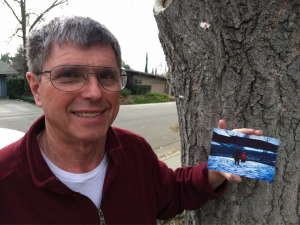
10. Ginkgo
(Ginkgo biloba)
Location: 913 Kent Drive
Nominator: Darrell Rash
Perhaps inspired by this tree, neighbors have planted other ginkgos along the street to replicate its splendor.
Category: Unusual History
Age: 46
Height: 60 ft
Spread: 40 ft
Girth: 5.2 ft
In the early 1970’s the city planted ginkgo trees in the front yards of new homes along Kent Drive, near Covell and Anderson Roads. Many of the trees died and were being replaced. Darrell Rash’s family lived in one of the first homes built on Kent Drive. The top of their new tree broke out, but a small lateral branch bent upward to take its place. The Rash family saw something promising in that twisted stem, and convinced the city crew not to remove and replace their tree. Over the ensuing 45 years that ginkgo tree has thrived and now stands as a landmark along the street. It is 60-ft tall with a girth of 5.3 feet. Every fall the Rash family enjoys the foliage’s buttery yellow color, and the beautiful patterns made on the ground after falling all at once.
Ginkgos are notoriously slow growing, but can live a very long time. Thanks to the efforts of the city, as well as past and current Kent Dr. residents, future generations will enjoy the many wonders that mature gingko trees have to offer.
11. Italian Stone Pine
(Pinus pinea)
Location: 1012 Plum Lane
Nominator: Louise Conrad
Very few residents of our streets in Davis are as lucky as those on Plum Lane, where a majestic Italian stone pine casts a spell of awe. The 55-year old tree was nominated by Louise Conrad because she always enjoys seeing it on her neighborhood walks. The current resident of 1012 Plum Lane, Leilani Buddenhagen, says that the owl feathers she finds under the tree remind her of its many denizens. The 100-ft tall towering conifer can be seen for blocks, and its umbrella-shaped crown casts shade across the entire street. Up close, its 10.2 ft girth and thickly plated, red-brown bark impress. The tree’s deep green foliage has a calming effect.
In fact, a young woman used to regularly meditate under this tree. One can’t help but wonder about the many memories children of Davis carry who grew up climbing its trunk and swinging from its branches.
Category: Unusual Size
Age: 55
Height: 100 ft
Spread: 60 ft
Girth: 10.2 ft
12. Tipa
(Tipuana tipu)
Location: 2136 Saratoga Place
Nominator: Robin Whitmore/ Carl Winter
Another unusual tree that found a home on Saratoga Place in west Davis, but is frequently found in tropical climates is the Tipa tree. About to landscape their new home, Robin Whitmore’s twin brothers from Southern California suggested this species. After doing some research, she and Carl Winter planted their tree next to a greenbelt 25 years ago. They love its filtered shade and bright orange-yellow blossoms in early summer. It has grown rapidly to 90-ft tall and 70-ft wide (10.4 ft girth).
Although this species is native to Brazil, it seems well-adapted to our clay soils and hot dry summers.
The Tipa is semi-deciduous in our climate—it will lose leaves slowly over the winter, more so if we get really low temperatures. The shallow roots can heave sidewalks, so it should be planted in parks and other large open spaces. Because of its fast growth, young Tipa trees require frequent formative pruning.
Category: Unusual Species
Age: 25
Height: 94 ft
Spread: 72 ft
Girth: 10.5 ft
13. Wollemi Pine
(Wollemia nobilis)
Location: 2136 Dinosaur Place
Nominator: Paul Kelly
Paul Kelly lives on Dinosaur Place in West Davis, and has a dinosaur-era relic growing in his front yard. A Wollemi pine emerges like a cathedral spire from a mass of plants.
This plant, a conifer but not a true pine, was thought to have gone extinct 2 million years ago, with fossils dating back to 200 million years ago. In 1994 a small grove of about 100 trees was discovered by explorers in Australia’s Blue Mountains.
Kelly obtained the tree in 2007 after learning about the National Geographic Society’s effort to help protect the species and safeguard its continued survival. Since he planted it as a 10-inch-tall seedling it has grown to 11-feet tall. The Wollemi pine’s evergreen foliage is unique, resembling something between two other members of the Araucaria family, the bunya-bunya and Norfolk Island pine. On close inspection, its bark looks like bubbling chocolate. Hopefully, the Kelly family’s tree will continue to thrive and eventually approach a mature height of 100 feet.
Category: Unusual Species
Age: 12
Height: 11 ft
Spread: 5
Girth: 1
14. Red Push Pistache
(Pistacia x ‘Red Push’)
Location: 115 Grande Avenue
Nominator: Susan and John Harada
This Red Push pistache was planted 20-years ago as an experiment. It is a hybrid between P. atlantica and P. integerrima with compound leaves that emerge with a distinctive red color, hence the name Red Push.
It has a lovely display of red, orange, and yellow color in the fall. It has proven to be drought tolerant and pest resistant. It seldom produces fruit and stays relatively small and compact. This tree is a good alternative for the Chinese Pistache, which is often over planted.
Category: Unusual Species
Age: 20
Height: 30 ft
Spread: 27 ft
Girth: 3.4 ft
15. Coast Redwood
(Sequoia sempervirens)
Location: Davis Community Church, 4th Street
Nominator: Alan Hirsch
This 110-ft tall Coast redwood has stood guard over Davis Community Church for nearly 100 years. But it is still just a juvenile, as the species are among the oldest things on Earth, living over 2000 years and reaching up to 380 feet in height.
A gigantic Coast redwood was nominated as a Great Tree by Alan Hirsch because it stands like a guardian at the entrance to the Davis Community Church. According to Dennis Dahlin, the tree was planted in about 1926 when the sanctuary building was completed.
Dahlin also notes that the cypress tree just east of the main entrance is known as the “Gethsemane Tree” as it was reportedly grown from a seed gathered in the Garden of Gethsemane in Palestine. Both of these trees are on the City of Davis Landmark Tree List.
Category: Unusual Size
Girth: 20 ft
Age: 93
Height: 110 ft
Spread: 60 ft
Girth: 15.7 ft
16. Cork Oak
(Quercus suber)
Location: 240 2nd Street
Nominator: Craig Reynolds
Cork oak are native to the Mediterranean region, and are pyrophytes – meaning their insulating cork bark allows them to survive fires.
Davis has more than its share of enormous cork oaks but few if any can compare to the prodigious size of the tree on 2nd St., across from the Black Bear Diner. This titan is wider (85 ft) than tall (75 ft) with a 12.5-ft girth. Its pendulous branches reach across the street, while its thick trunk is splayed across much of the sidewalk. As nominator Craig Reynolds notes, “the corky bark is right there to touch.” He admires its well-balanced crown and ability to thrive in an entirely urban environment.
Harvesting the cork remains one of the few activities that depends solely on human labor because of the skill required. Stop by this tree and admire its stature, resilience, and spongy bark.
Category: Unusual Size
Height: 74 ft
Spread: 84 ft
Girth: 12.5 ft
17. Olive
(Olea europaea)
Location: North of Sproul Hall, UCD
Nominator: Richard Plant
The ancient olive tree that stands North of Sproul Hall on the southeast corner of the UC Davis campus caught the eye of Dr. Richard Plant.
A professor for 44 years at UCD, Dr. Plant nominated this tree because it’s spiraling trunk and gnarled branches reflect the vicissitudes of over 150 years of life.
This olive is 60–ft tall and its girth is 8.7 feet. It is one of several trees that remain from the Jerome C. and Mary Chiles Davis homestead. A nearby plaque notes that these olive and fig trees are relics from the prize winning farm of the 1850s. In 1867, after the Davis’s retired from farming, the homestead became Davis’s first hotel, the Yolo House. A portion of the farm became University Farm in 1906, and later UC Davis.
Category: Unusual Species
Age: 150+
Height: 60 ft
Spread: 40 ft
Girth: 8.7 ft
18. Torrey Pine
(Pinus torreyana)
Location: UCD Arboretum, Redwood Grove
Nominator: Roberta Millstein
There are several large Torrey pine in the UC Davis Arboretum. The largest grows among the redwoods, towering 130-ft tall with a girth of 13.5 feet. According to Warren Roberts, superintendent of the UC Davis Arboretum, the tree was planted in 1941 when most trees in the T. Elliot Weier Redwood Grove were planted. This tree was nominated by Roberta Millstein, who loves the majestic character of Torrey pine trees.
She writes, “In their native habitats, Torrey pines are gnarled from the wind. The one in the arboretum grows straight and tall. It illustrates the huge role that environment plays in an organism’s development — a lesson for us all!”
Native stands of Torrey pine are restricted to coastal Southern California, and the species is considered one of the rarest pines in the world. As this Great Tree demonstrates, in gardens with rich soil and ample moisture, Torrey pine can grow much taller than the 60-ft mature trees found in the wild.
Category: Unusual Form
Age: 68
Height: 129 ft
Spread: 78 ft
Girth: 13.5 ft
19. Valley Oak
(Quercus lobata)
Location: South Putah Creek
Nominator: Anonymous
Well before Davis was a settlement, the roots of this immense Valley oak plunged deep into the moist soil of old Putah Creek in south Davis. According to an anonymous nominator, this tree is estimated to be 380 years old. It stands 95-ft tall with a 20-ft girth.
In 1860 a new Pony Express route passed under the boughs of this tree, with riders changing horses at nearby Solano Station.
Since then it has shaded hundreds of weddings and wine tastings for the old Putah Creek Vineyard. Today this massive tree shelters and feeds an eclectic assemblage of hawks, owls, vultures and other creatures. Its twisted trunk and ponderous, gnarled branches attest to a long, hard life marked by flood, subsidence, drought, and cold. With our help, this iconic Valley oak will continue to awe us for another 380 years.
Category: Unusual Size
Age: 380
Height: 96 ft
Spread: 50 ft
Girth: 20 ft
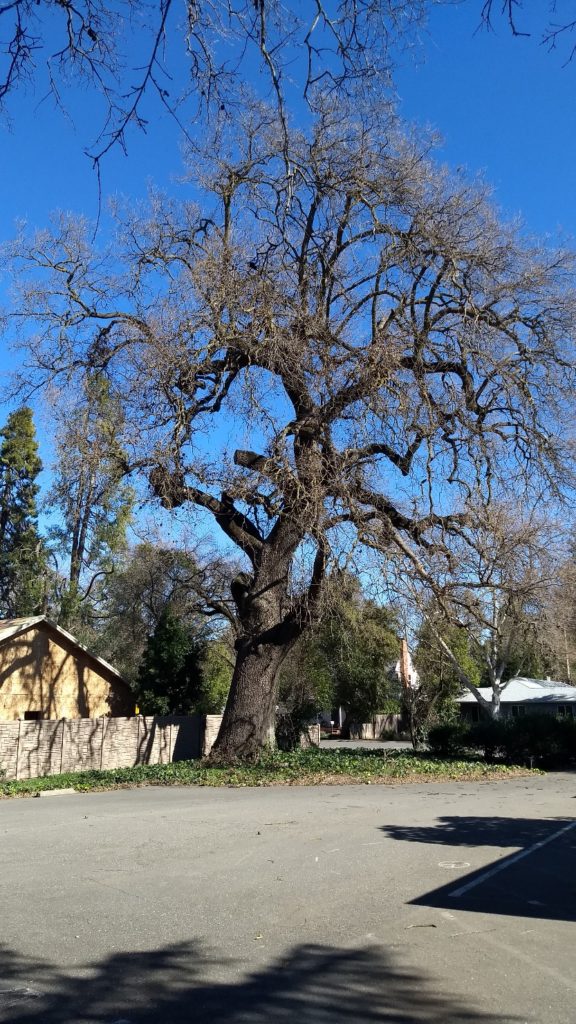
20. Valley Oak
(Quercus lobata)
Location: 501 Oak Ave.
Nominator: Warren Roberts
The Valley oak at 501 Oak Ave. is the largest tree measured during the Great Tree Search. It’s 21-ft girth slightly exceeds that of the 380-year-old giant along old Putah Creek in south Davis. This oak is 120-ft tall with similar crown spread. It was over 200 years old when European immigrants began to settle here in the 1840s. This massive living landmark can be called a “Witness Tree,” an expression for trees that rested at the corners of parcels when surveyors divvied up land. Oak Ave. was likely named for this tree. Hopefully it will continue to grace the neighborhood with its uncommon beauty for generations to come.
Category: Unusual Size
Height: 120 ft
Spread: 120 ft
Girth: 20.9 ft
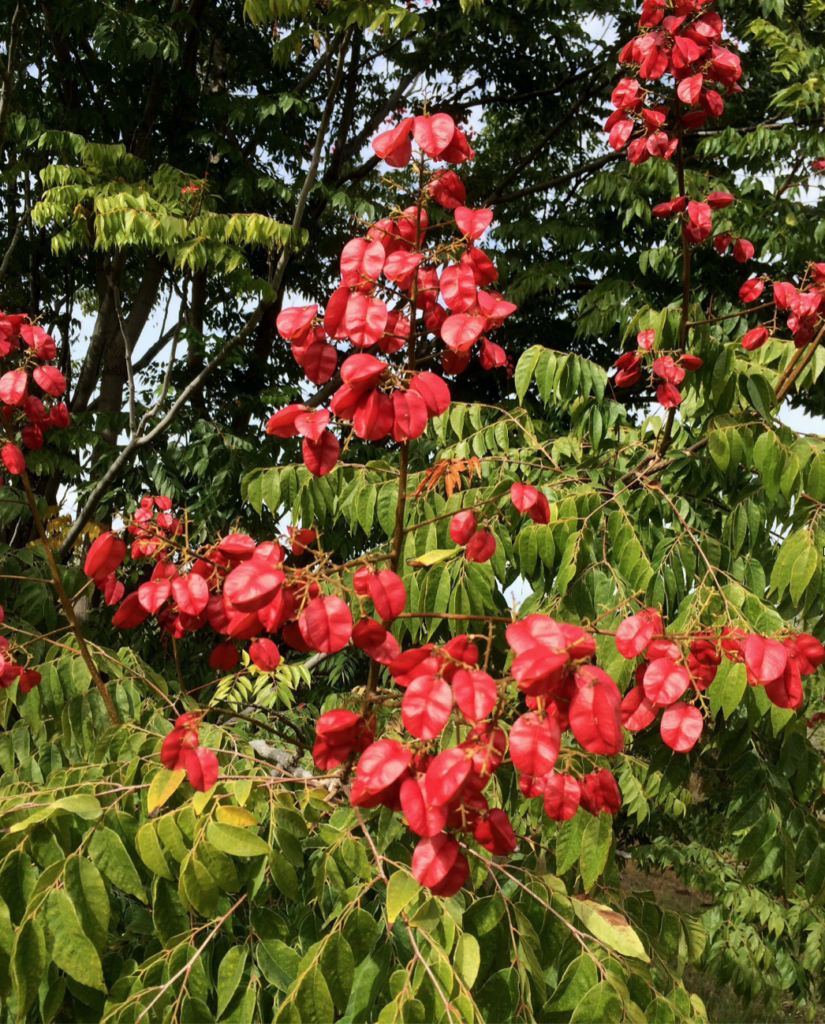
21. Formosan Flame
(Koelreuteria elegans subsp. formosana)
Location: 345 L St
Nominator: Warren Roberts
The Formosan Flame tree behind the Friends Hall at 345 L St. is one of the largest in Davis. The crown of this veteran reaches 70 feet and spreads 60 feet. With a girth of 9.6 feet it is almost the size of its cousin at the northwest corner of 8th and L St. These two trees were likely planted at the same time in 1961. Every fall their crowns are adorned with lipstick pink capsules that follow attractive yellow flowers. Warren Roberts, superintendent of the UC Davis Arboretum, nominated this tree and has long been a proponent of the Formosan Flame.
Category: Unusual Size
Age: 57
Height: 70 ft
Spread: 60 ft
Girth: 9.6 ft
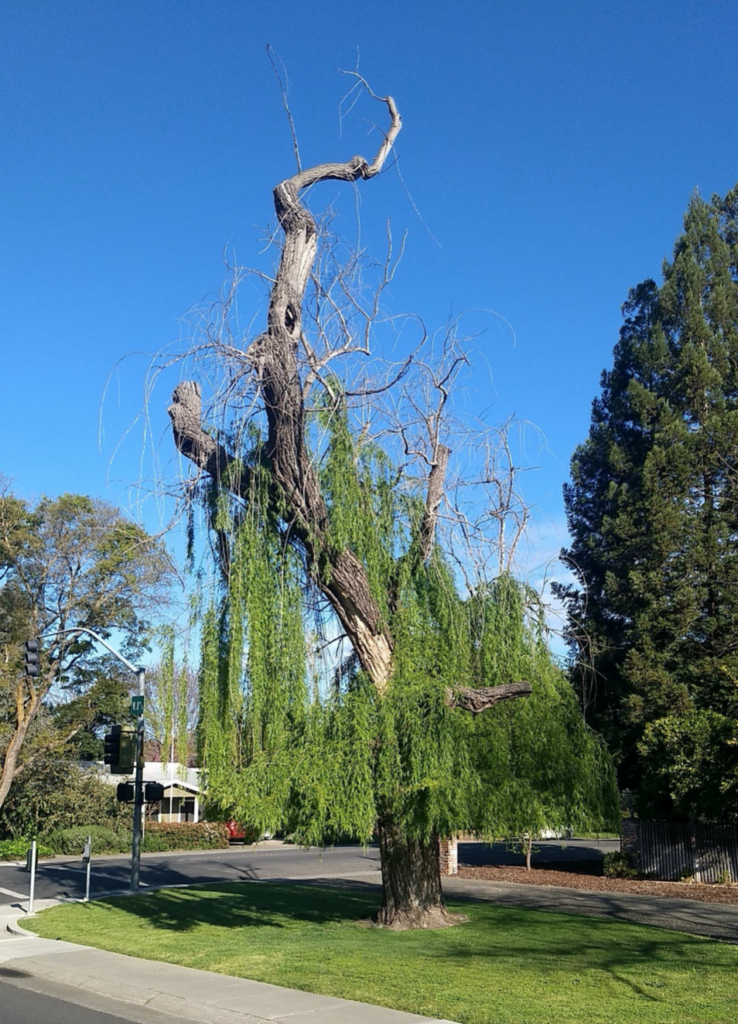
22. Weeping Willow
(Salix babylonica)
Location: 375 W. 8th St.
Nominator: Warren Roberts
Some trees just refuse to die. Such is the case with the weeping willow at 375 W. 8th St. Although the exact planting date of this tree is unknown, it was already a large tree in the early 1960s. At the turn of the century it was a magnificent specimen that visually dominated the intersection of 8th and Oak St. It’s spread exceeded its 50-ft height and its pendulous branches gracefully brushed the ground. Over the past decade pests, disease and other stressors have reduced the crown to a skeleton of its former self. The thick, gnarled trunk (9.8-ft girth) supports a crown that barely spreads to 30 feet. As in a horror film, it seems to shrink every year, returning like a zombie tree.
Category: Unusual Size
Height: 50 ft
Spread: 30 ft
Girth: 9.8 ft
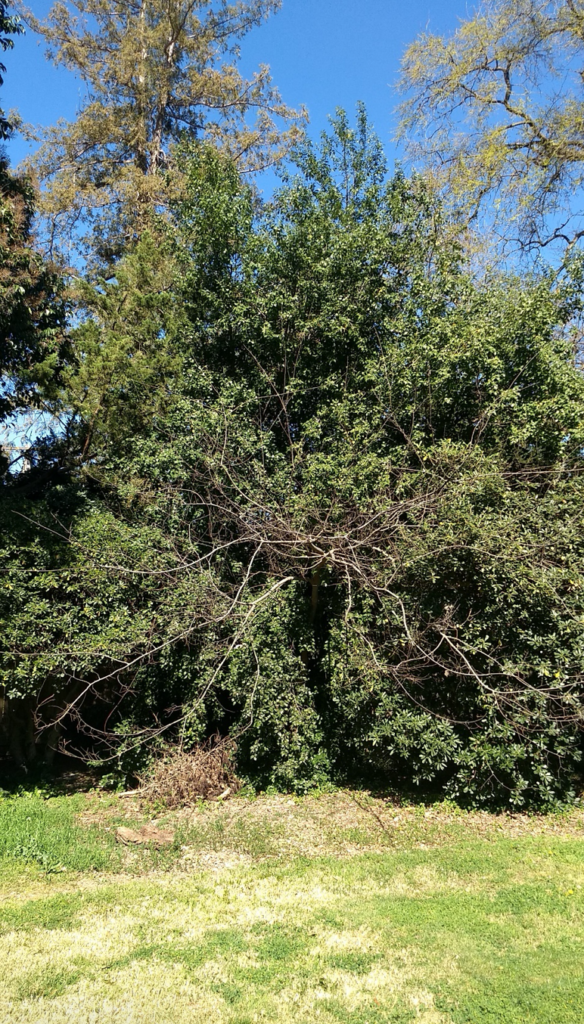
23. Shiny Xylosma
(Xylosma congestum)
Location: College Park
Nominator: Warren Roberts
A shiny xylosma hides behind the privets, oaks and other plants along the north border of College Park. This multi-stemmed tree reaches upward 45 feet for the sun. Like an octopus trying to escape a trap, a hackberry tree grows out through the middle of the xylosma’s crown. Xylosma is normally a hedge plant that reaches 10-ft tall, so this is an unusually lofty specimen. Extracts from the evergreen foliage have medicinal uses.
Category: Unusual Size
Height: 45 ft
Spread: 20 ft
Girth: 2.5 ft
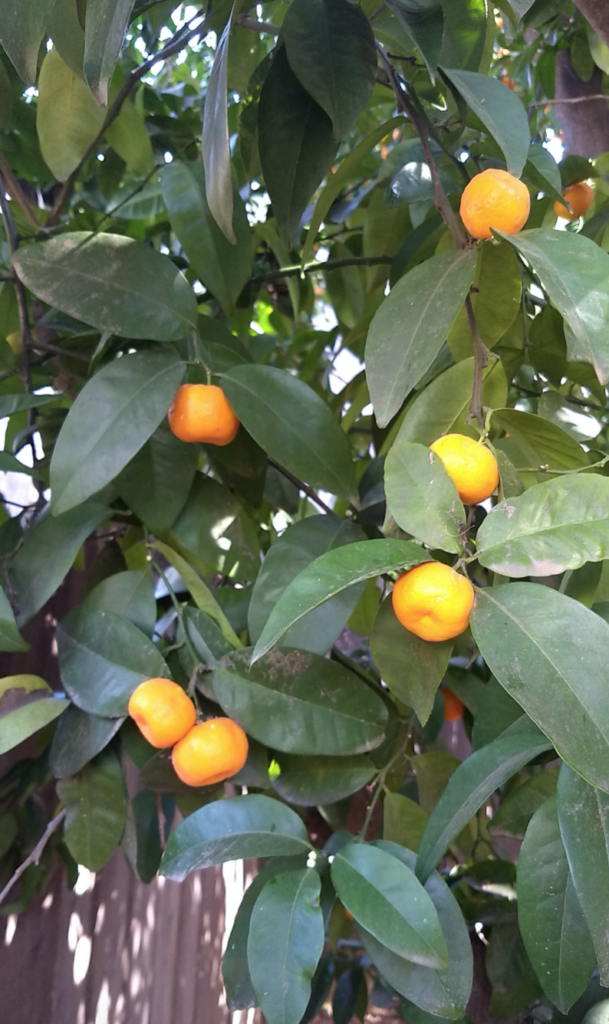
24. Calamondin
(Citrofortunella microcarpa)
Location: 512 K St.
Nominator: Warren Roberts
Calamondin is a species of citrus and a hybrid between kumquat and mandarin orange. The calamondin at 512 K St. reaches 20-ft tall with a 14-ft crown spread. Usually a shrub, this calamondin provides ample shade and tasty fruit with a distinctive sweet (peel) and sour (fruit) flavor when eaten whole. The fruits are used to make marmalade, juices, sauces, and cake.
Category: Unusual Size
Height: 30 ft
Spread: 30 ft
Girth: 4.1 ft
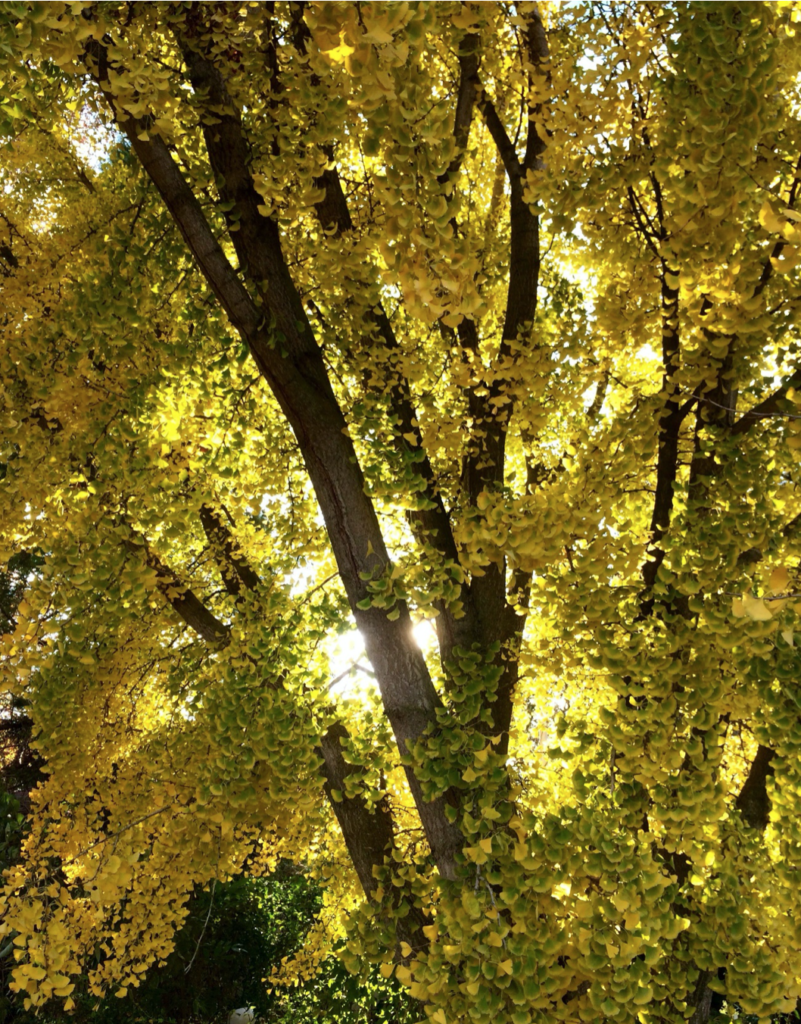
25. Ginkgo
(Ginkgo biloba)
Location: 943 Ponderosa Place
Nominator: Warren Roberts
Ginkgo trees are very slow growing, which makes the 65-ft tall one in front of Wilhelmina Currie’s home at 943 Ponderosa Place even more spectacular. The trunk of this ginkgo has a 5.6-ft girth that supports a crown 36-ft in diameter. She loves the leaves, which look like dinosaur footprints and turn buttery yellow in the fall.
Category: Unusual Size
Height: 65 ft
Spread: 36 ft
Girth: 5.6 ft


26. Canary Island Pine
(Pinus canariensis)
Location: 43351 Almond Lane
Nominator: Mont Hubbard
The Canary Island pine towers 96 feet above Mont Hubbard’s home. It is located at 43351 Almond Lane, in what was an almond orchard before the Willowbank subdivision was developed in 1947. Its hefty trunk has a girth of 15 feet and supports a massive crown that spreads 70 feet. It was planted about 65 years ago when the home was built. The tree has sheltered owls and attracted hawks. About 15 years ago a nest was blown out of the tree. Hubbard and his daughter built a hawk nest and climbed high into the crown to secure it. They are still waiting for new neighbors to call it home.
Category: Unusual Size
Age: 65
Height: 96 ft
Spread: 70 ft
Girth: 14.9 ft
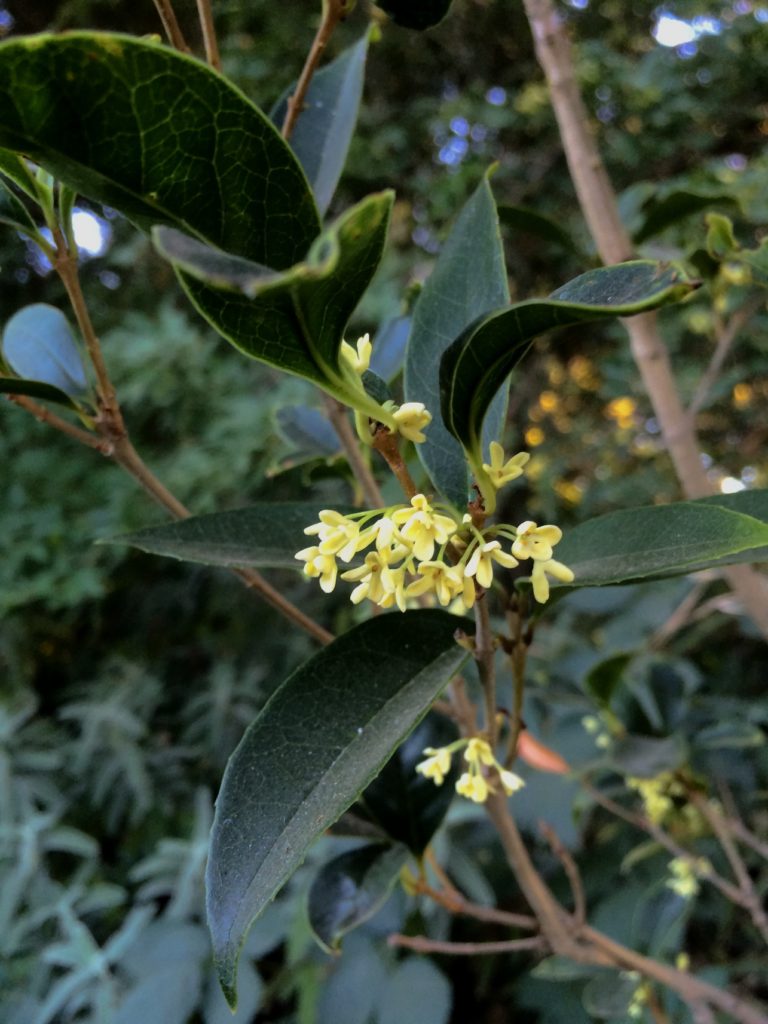
27. Sweet Olive
(Osmanthus fragrans)
Location: 939 Pecan Pl.
Nominator: Warren Roberts
Sweet olive is an evergreen shrub or small tree native to Asia with extremely fragrant flowers that smell like ripe peaches. Although very popular in Japan and China where it is the “city tree” of several municipalities, it is unusual in Davis. The sweet olive planted by the late Dr. Andrew Leiser at his home on 939 Pecan Pl. has grown into a 30-ft tall tree. Leiser was one of the finest plantsmen in California and studied woody plants with horticultural potential. Sweet olive was one of these. With a girth of nearly 4 feet, this tree is enormous for its kind, and when in flower its delicious scent permeates the neighborhood.
Category: Unusual Species
Height: 30 ft
Spread: 25 ft
Girth: 3.9 ft

28. Mexican Evergreen Oak
(Quercus rysophylla)
Location: 1324 Torrey St.
Nominator: Lucy B Della Rosa
The Mexican evergreen oak planted by the late UC Davis professor John Tucker is another one of Davis’ arboreal legacies. Tucker was a world-renowned oak expert whose research led to the Shields Oak Grove at the UCD Arboretum. Oddly, in Davis this species is only found in the backyard of his former residence at 1324 Torrey St. Its acorns are prized by collectors. The tree is 50-ft tall, with a 30-ft spread and 4.5-ft girth. Its interesting foliage, drought tolerance, and resistance to disease and pests make it a good choice for contemporary landscapes.
Category: Unusual Species
Height: 50 ft
Spread: 30 ft
Girth: 4.5 ft

29. Mexican Blue Palm
(Brahea armata)
Location: 2136 Dinosaur Pl.
Nominator: Paul Kelly
Paul Kelly’s backyard contains palms from around the world, but the Mexican blue palm is his pride and joy. This 70-year old tree was transplanted by crane (it weighed 10,000 pounds) 7 years ago from a site in West Sacramento. Now it is 30-ft tall and the stout trunk has a girth of 6.1 feet. It is believed to be the largest of its kind in Davis. The Mexican blue palm is known for its distinctly bluish fronds and white flower stalks that arch well beyond the crown. This fan palm is native to Baja California and drought tolerant. The photo shows the tree as seen from Shasta Dr.
Category: Unusual Species
Age: 70
Height: 30 ft
Spread: 15 ft
Girth: 6.1 ft
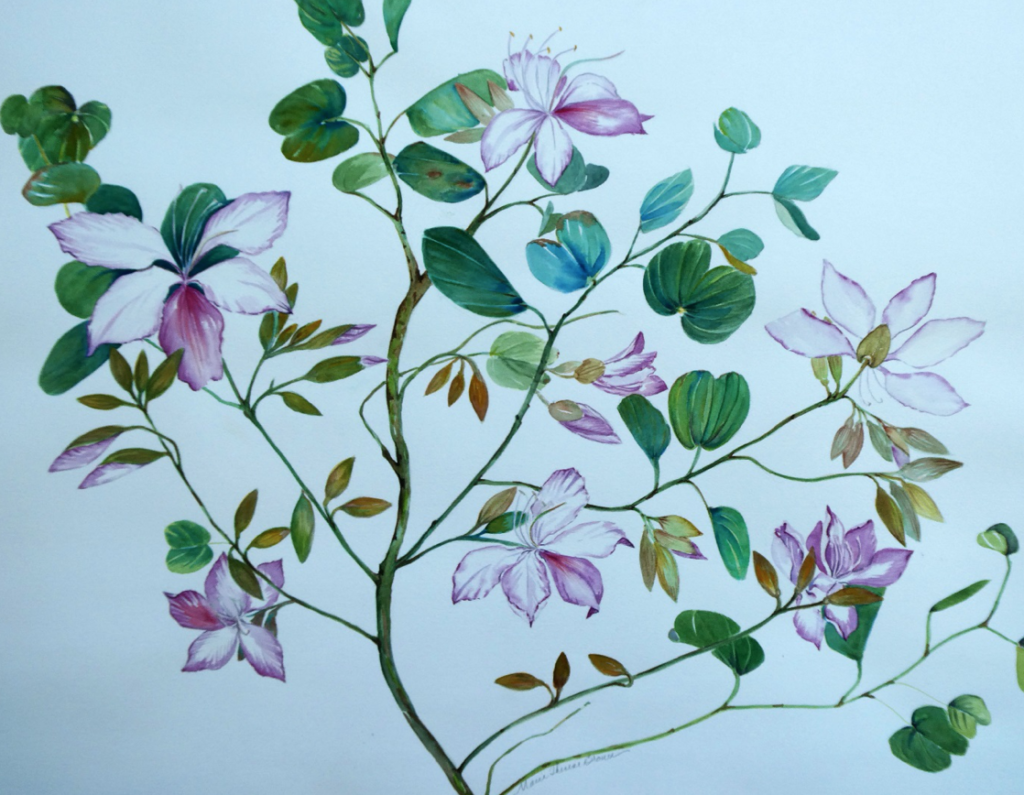
30. Orchid Tree
(Bauhinia x blakeana)
Location: 648 D St.
Nominator: Marian Stephenson
At 648 D St. there is a tree that goes unnoticed except when its flowers. The 35-ft tall orchid tree has died back from cold snaps and sprouted several times. The four scarred stems are testaments to its tenacity. In spring the light pink orchid-like flowers are spectacular, and their fragrance intoxicates. A wonderful watercolor painting by local artist Marie-Therese Brown aptly captures the delicate beauty of these flowers. The twice lobed leaves are interesting as well. This Great Tree is truly a hidden gem.
Category: Unusual Species
Height: 35 ft
Spread: 40 ft
Girth: 3.9 ft
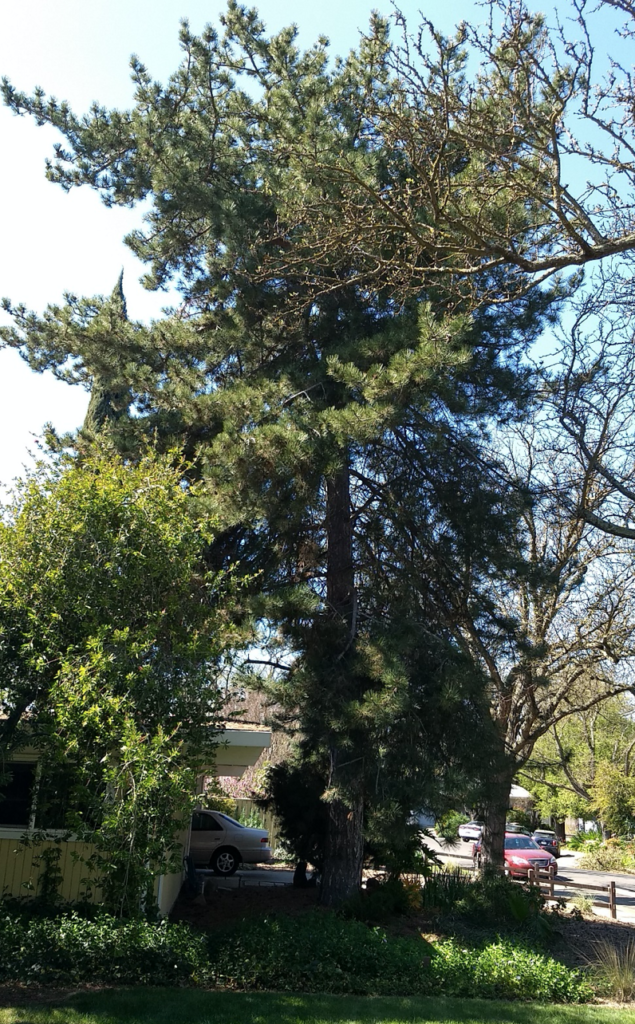
31. Austrian Pine
(Pinus nigra)
Location: 1132 Dartmouth Place
Nominator: Warren Roberts
Austrian pine is not common in Davis, and the one at 1132 Dartmouth Pl. is uncommonly large. According to Ms. Grace Hodgson, the tree is nearly 60 years old. Its spreading canopy and dark-colored bark make the front yard stand out. This specimen is 70-ft tall and has a girth of 5.5 feet. It is home to many birds, squirrels and occasionally a raccoon.
Category: Unusual Species
Age: 60
Height: 70 ft
Spread: 36 ft
Girth: 5.5 ft
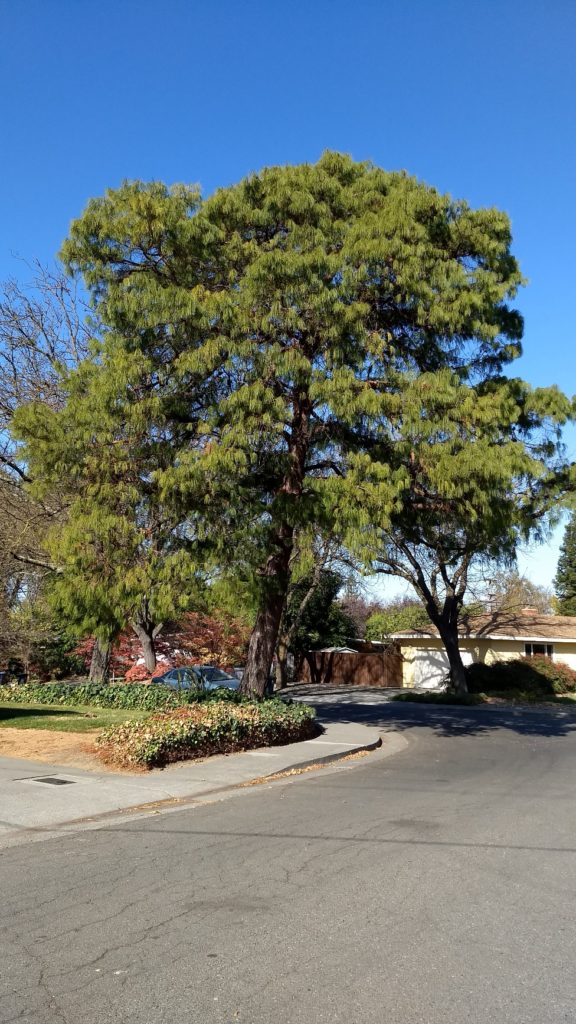
32. Mexican Weeping Pine
(Pinus patula)
Location: 1140 Dartmouth Pl.
Nominator: Warren Roberts
Next door at 1140 Dartmouth Pl. is a beautiful Mexican weeping pine. Although not as tall (55 ft) as the Austrian pine, this tree has a gorgeous spreading crown (48-ft spread) and drooping tufts of needles. The stout trunk (6.5-ft girth) and feathery foliage are very attractive. Native to the highlands of Mexico, the Mexican weeping pine is quite drought resistant and merits increased use as an ornamental tree in Davis.
Category: Unusual Species
Height: 55 ft
Spread: 48 ft
Girth: 6.5 ft
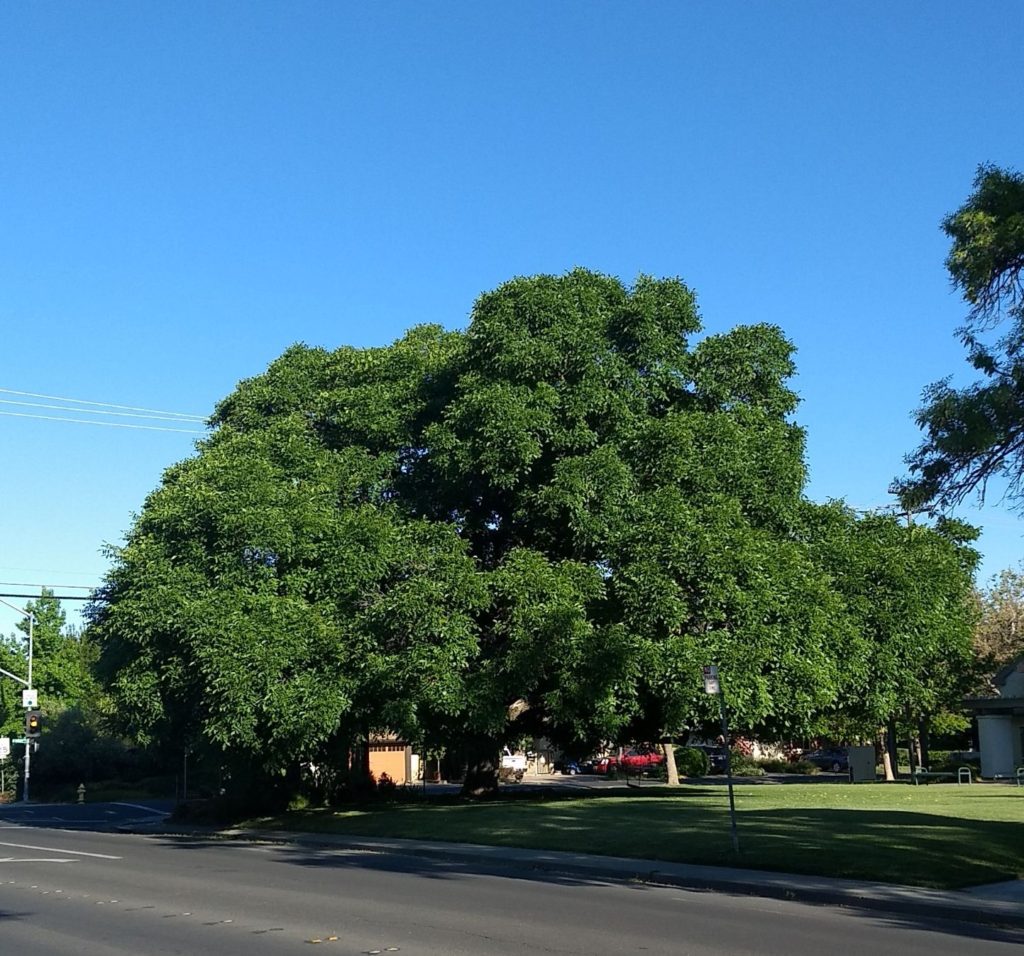
33. Paradox Walnut
(Juglans hindsii x J. regia)
Location: 317 E. 8th St.
Nominator: Larry Guenther
One of the most visible trees in Davis is the Paradox walnut that stands in front of the Lutheran Church at 317 E. 8th St. Its enormous branches defy gravity, sweeping downward and then lifting upward to the sky. The crown spreads 90 feet, greatly exceeding its height (65 ft). This tree was probably planted by active congregation member Harold Forde who, along with Eugene Serr, began the walnut breeding program at UC Davis in 1948. Luther Burbank produced the first Paradox walnut by cross pollinating our native black walnut with English walnut. He named it Paradox because it displayed traits uncommon to both parents, such as rapid growth, few walnuts, and very strong wood.
Category: Unusual Species
Height: 65 ft
Spread: 90 ft
Girth: 11.0 ft

